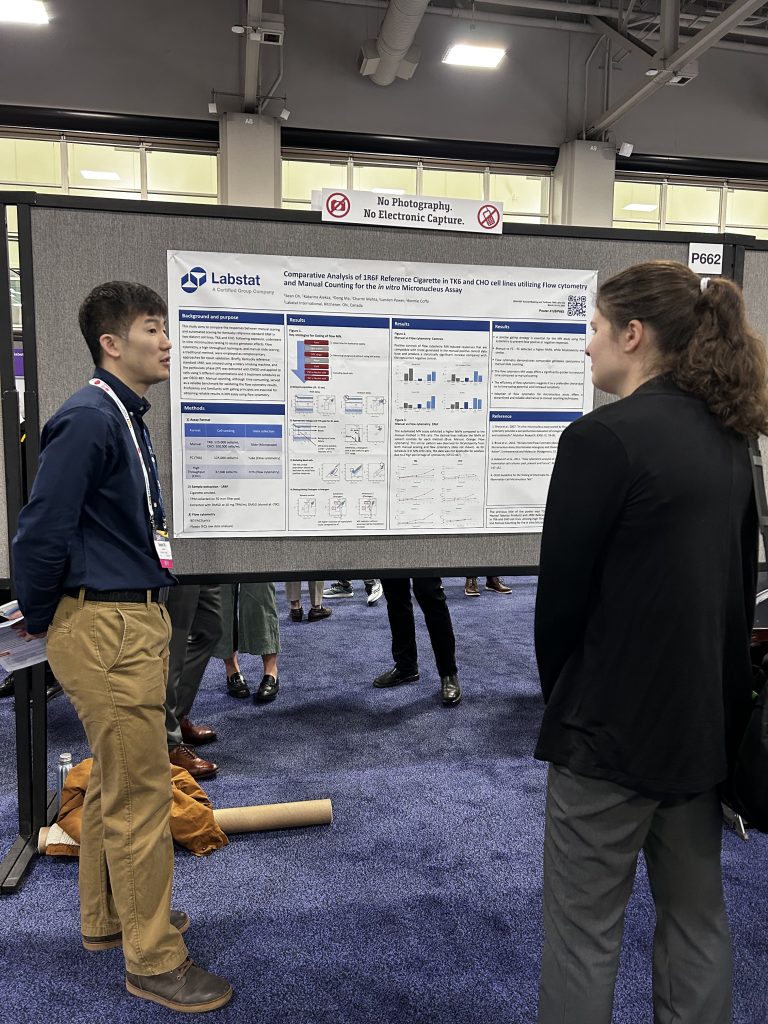Highlights from the Society of Toxicology 2024 Annual Meeting in Salt Lake City, Utah
The Society of Toxicology (SOT) Annual Meeting is a prestigious event that gathers scientific experts from around the world to share the latest advancements in toxicology. This year’s assembly, held in Salt Lake City, showcased an array of groundbreaking research, with poster presentations offering intriguing insights into various aspects of toxicology.
The event brought together 5,000+ toxicologists and those working in areas related to toxicology. More than 70 Featured and Scientific Sessions took place alongside 2,000+ poster presentations and the three-day ToxExpo, featuring 250 companies.
Below are some of the highlights from the nicotine posters presented at the event.

Modern Oral Nicotine Pouches:
Multi-endpoint In Vitro Toxicity Assessment of Snus and Tobacco-free Nicotine Pouch Extracts
British American Tobacco presented a study focusing on a comprehensive evaluation of snus and tobacco-free nicotine pouch extracts. Employing a multifaceted approach, including ToxTracker®, Ames, NRU, and genotoxicity assays, the study highlighted the necessity of considering multiple endpoints for a robust assessment of comparative risk. The findings indicated that nicotine pouch extracts exhibited lower biological activity across all tested endpoints compared to snus extracts.
Comparison of In Vitro Nicotine Dissolution Profiles Across a Range of Oral Nicotine Products
Valeo Sciences conducted a comparative analysis of nicotine dissolution profiles across various oral nicotine products. Interestingly, products with similar reported nicotine strengths demonstrated diverse timing and peak nicotine releases. Notably, modern oral nicotine pouches exhibited the potential for faster and higher nicotine doses compared to pouched snus products.
Development of a 3D Buccal Tissue Model to Evaluate the In Vitro Permeation of Nicotine and Tobacco Specific Nitrosamines from Smokeless Tobacco Product Extracts
RAI Services Company presented a 3D buccal tissue model developed to evaluate the in vitro permeation of nicotine and tobacco-specific nitrosamines (TSNAs) from smokeless products. The study observed consistent and concentration-dependent cumulative permeation of nicotine and TSNAs over a two-hour period.
Hazard Identification and Risk Assessment of Non-Nicotine Ingredients in Oral Nicotine Pouches
Altria Client Services presented a comprehensive risk assessment of non-nicotine ingredients in oral nicotine pouches (NP). In parallel, a test NP product (i.e., mint NP containing maltol and ethyl maltol) was tested in vitro and in vivo for genotoxicity (studies presented separately: Farcas et al. and Zhang et al., respectively), and the results show that while NP extracts containing maltol and ethyl maltol might drive in vitro genotoxicity responses, there were no in vivo sequelae. The weight of evidence indicates that both maltol and ethyl maltol are not mutagenic or genotoxic at the levels examined in the test products, or under conditions of oral use of nicotine pouches. Despite conflicting toxicity data on ingredients like maltol and ethyl maltol, the weight of evidence suggested their safety at levels examined in test products, even after a lifetime of use.
Evaluation of the In Vivo Genotoxic Potential of an Oral Nicotine Pouch Product Following ICH S2(R1) Guidance
Altria Client Services evaluated the in vivo genotoxic potential of mint oral nicotine pouches. While the products exhibited genotoxicity in vitro, no adverse effects were observed in in vivo assays, highlighting the importance of comprehensive assessment methods.
Comparative Toxicity Assessment of the Harm Reduction Potential of Tobacco-Free Oral Nicotine Products
Swedish Match, in partnership with Labstat, conducted an assessment of the effects of ZYN® pouch products in comparison to snus, CRP 2.1, and 1R6F in the ToxTracker® assay. The study found that ZYN® products did not elicit GFP expression across any of the reporter strains. In contrast, 1R6F induced expression of SrnX1 (indicating oxidative stress), Ddit3 (signaling protein damage), and Btg2 genes (suggesting toxicity via non-genotoxic pathways). Additionally, CRP2.1 induced expression of Ddit3 and Srxn1 genes, while snus extracts only induced Ddit3 expression.

In Vitro Toxicological Assessment of Modern Oral Nicotine Product Extracts in the Ames, Micronucleus and Neutral Red Uptake Assays
RAI Services Company in collaboration with Labstat, evaluated the in vitro toxicology of modern oral nicotine product (MO) extracts as compared to combustible cigarette (CC) TPM. No mutagenic activity was observed for any of the MO and oral comparator CAS extracts across all tester strains. However, CC TPM showed mutagenicity in strains TA98 and TA100 (with or without metabolic activation) and TA1537 (with metabolic activation). Additionally, CC TPM induced genotoxicity, and exhibited cytotoxicity (with an IC50 of 4 µg nicotine equivalents / mL) in the NRU assay. In contrast, MO and oral comparators did not induce micronuclei (IVMN) or cytotoxicity (NRU), except for one MO test item, which showed flavor-specific effects. Overall, the in vitro test battery results presented add to the WoE that MO nicotine products have reduced in vitro toxicity compared to combustible cigarettes.
Heated Tobacco Products (HTPs)
In Vitro Toxicological Evaluation of Concentrated Aerosol Collected Mass Extracts from Heated Tobacco Products with Indirect Heating System
Japan Tobacco explored the toxicological profile of concentrated solvent-free aerosol extracts from HTPs with an indirect heating system. Despite higher extract concentrations, no additional toxicity was observed compared to traditional extracts.
Can Heated Tobacco Products be Considered Less Harmful than Cigarettes? A Comparative Study Characterizing their Emissions and Determining their Genotoxic Potential on Human Bronchial Epithelial Cells.
Researchers from the Netherlands Food and Consumer Product Safety Authority, RIVM, and Maastricht University conducted a study comparing emissions from HTPs and conventional cigarettes. While both emitted harmful and potentially harmful constituents (HPHCs), HTP emissions contained substantially lower levels, indicating potential harm reduction. Both cigarette smoke extract and IQOS® extract were found to contain radicals, induce oxidative DNA damage and downregulate DNA repair gene expression.
Analysis of Characteristic Components Glycidol and Chloropropanols in Heated Tobacco Products and e-Cigarette Aerosols
China National Tobacco Quality Supervision & Test Center developed an analytical method to detect glycidol and chloropropanols in HTP and e-cigarette aerosols. The release of glycidol, along with 3-MCPD and 2-MCPD in HTP aerosols, and glycidol in e-cigarette aerosols, showed significant differences when compared to conventional cigarettes.
Comparative Toxicity Assessment of Oral Nicotine Pouches to Combustible Cigarettes, Smokeless Tobacco Products and Market Nicotine Pouches Using Regulatory in vitro Cytotoxicity, Mutagenicity, and Genotoxicity Assays
Altria Client Services evaluated the toxicity of a heated tobacco capsule prototype. In comparison to CC (combustible cigarettes), the prototype HTCs and market HTPs showed ≥90% reduction in the measured HPHCs. In the Ames assay, all HTC prototypes, as well as market HTPs were not mutagenic even when tested at concentrations greater than the assay recommended maximum of 5 mg/plate. The GVP fractions were negative for mutagenicity in all tested products. In the NRU assay, both TPM and GVP from CC showed concentration-dependent cytotoxicity, whereas aerosol mass and GVP from HTC prototypes and market HTPs showed substantially lower cytotoxicity (>70% reduction in toxicity compared to CC). In the MN assay, all tested products showed genotoxicity; however, the genotoxicity with prototype HTCs and market HTPs were observed at >10-fold higher concentrations compared to CC. The genotoxicity of the HTC prototypes was within the range of responses observed with the market HTPs.

ENDS (E-vapor)
In Vitro Toxicological Evaluation and Comparison of Nicotine and Representative Nicotine Salts on Human Lung and Nerve Cells
China National Tobacco Quality Supervision & Test Center evaluated the cytotoxic and genotoxic effects of nicotine and representative nicotine salts. Nicotine tartrate exhibited higher cytotoxicity, while all test substances showed no increased risk of DNA or chromosomal damage in NCI-H292 and SH-SY5Y cells.
Machine Learning to Predict Respiratory Dosimetry of Tobacco Product Constituents
The FDA Center for Tobacco Products and Applied Research Associates employed machine learning to predict respiratory dosimetry of tobacco product constituents. Computational fluid dynamics simulations enabled accurate estimation of vapor uptake. The trained vapor uptake model for the rat nose was validated against vapor uptake of specific chemicals (carbonyls, propylene glycol, glycerol, etc.) from experimental studies and was able to reasonably predict uptake.
Evaluation of Chronic Toxicity and Carcinogenicity of Flavored E-vapor Aerosols in an 18-Month Inhalation Study in A/J Mice
Philip Morris International, Phillip Morris Products SA, and Altria Client Services presented data on an 18-month inhalation study in A/J mice exposed to cigarette smoke (CS) exposure and aerosols from a proto-type e-liquid formulation containing 38 flavors. Chronic exposure to e-vapor aerosols up to 18 months did not induce notable toxicity or carcinogenicity in the lung compared to air controls. E-vapor exposure resulted in either no exposure-related toxicological changes or, specifically in the PG/VG/Nicotine/Flavors-High concentration groups, changes were significantly reduced (larynx) compared to or comparable (olfactory epithelia) to CS-exposed mice.

Synthetic Nicotine:
Differential Analysis of Nicotinic Enantiomer Binding to an a7 Nicotinic Acetylcholine Receptor
Beijing Life Science Academy and China National Tobacco Quality Supervision & Test Center conducted experiments revealing differential binding affinities of nicotinic enantiomers to alpha7 nicotinic acetylcholine receptors. S-nicotine exhibited higher affinity, enhancing its biological activity.
These poster presentations represent just a fraction of the cutting-edge research showcased at the SOT 2024 Annual Meeting, illustrating the ongoing efforts to advance our understanding of toxicology and explore the harm reduction potential of emerging nicotine products.


